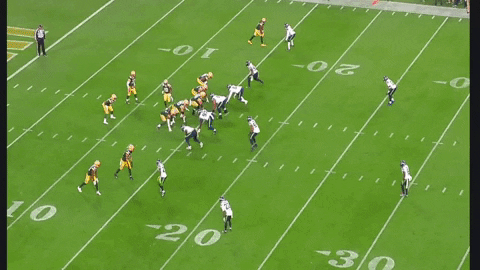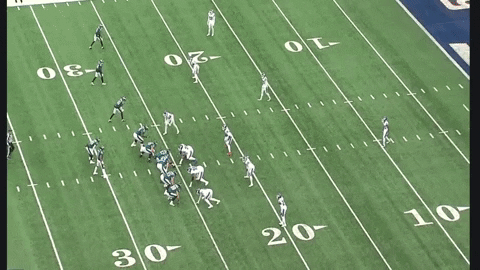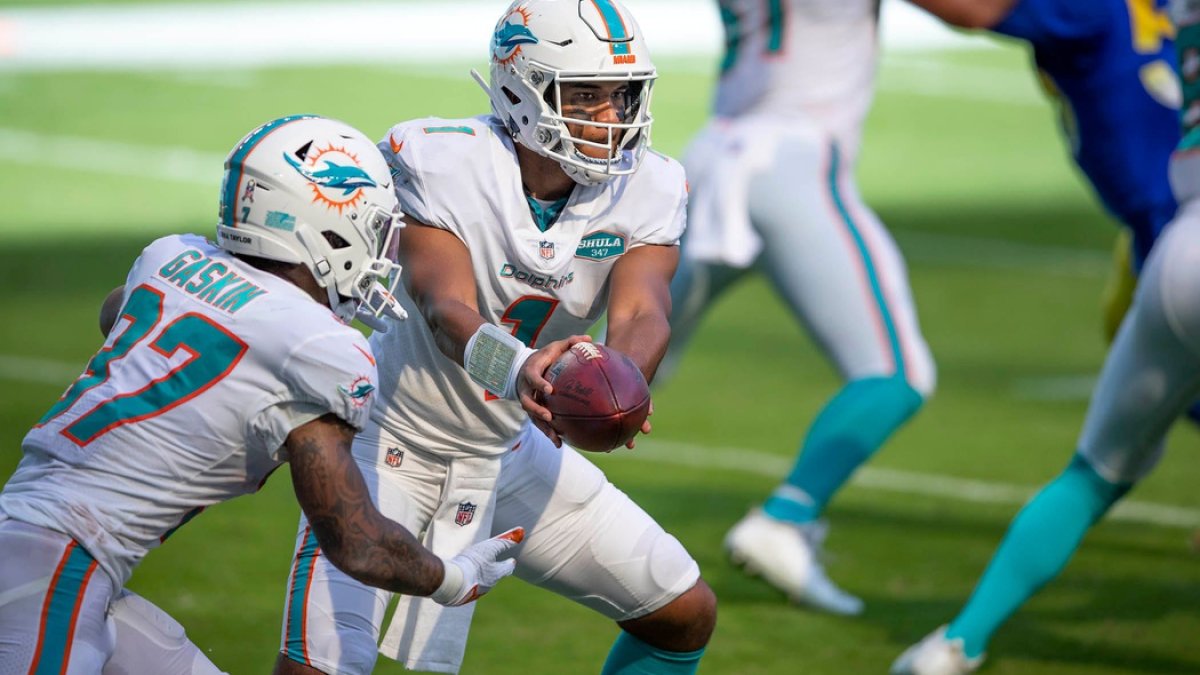There are some things that get an instant rise out of me, and always will.
Bad run fits are high on the list. Almost every week, I’m lambasting some poor three-technique or middle linebacker just trying their best to execute the delicate balance between violence, biomechanics and the fundamental laws of geometry and physics.
Click here for more PFF tools:
Rankings & Projections | WR/CB Matchup Chart | NFL & NCAA Betting Dashboards | NFL Player Props tool | NFL & NCAA Power Rankings
Poor clock management lives in this neighborhood, as well. I can still remember the way Los Angeles Chargers–Dallas Cowboys ended this season, and it still bothers me that an abominable approach to the end of that football game was rewarded by Greg Zuerlein nailing a much longer field goal than he needed to kick.
Nothing compares to RPO discourse, though. My most trusted colleagues have heard me rail against the run-pass option anytime it’s mentioned, at a degree that makes me wonder whether I’m suffering from Pavlovian-esque conditioning.
End the RPO era and prove to me that you’re the leader people say you are. @POTUS
— Diante Lee (@PFF_DLee) October 31, 2021
My issue with the concept doesn’t have anything to do with the functionality of the play, though it’d be nice if referees could see the largest humans on the field more than a yard downfield. The problem here is the large disconnect in our understanding of the contextual factors that explain what makes each RPO different, and why they’re called when they’re called.
For starters, there is a certain kind of aesthetic gratification viewers and analysts draw from passes thrown on RPO calls, in a way that makes it easy to assume the general function of an RPO is akin to a play-action or “pop” pass. Of course, there’s merit to using the concept in that way, which you can see from an offense such as the Miami Dolphins‘. The Dolphins lead the league in RPO “pulls” — meaning the quarterback is looking to throw) by 18 dropbacks and are first in yardage by a margin of over 200. By almost every raw metric, and many rate statistics, the Dolphins are the best RPO passing team in the NFL.
I'm not sure being the best RPO quarterback is actually the compliment we think it is https://t.co/JzWXaTQJPz
— Seth Galina (@pff_seth) November 30, 2021
The piece that completes the puzzle and explains how Miami has created such a chasm in its RPO production can be found in its average depth of target. Of the 13 teams with at least 25 RPO pulls this season, Miami leads the group with an average depth of target of just under 5.5 yards (almost a full yard ahead of second-ranked Buffalo). Slants (29%), fades (20%) and flat routes (18%) make up over two-thirds of the RPO routes wide receivers run in Miami but account for only 36% of the other 31 teams’ routes run.

Functionally and philosophically, the Dolphins are using their RPO passes in a way the rest of the NFL isn’t — to cover for the fact that they cannot move the ball on the ground at all. Entering Week 14, Miami ranks dead last in yards per carry (3.3). This tracks, given that an offensive line is more likely to block up a downfield RPO concept like a quick game pass than the typical zone scheme, to keep the quarterback protected.

| Team | RPO Pulls | Yds/Att. | Avg. Depth of Target | EPA Per RPO Pull |
| Dolphins | 78 | 8.2 | 5.4 | .303 |
| Chiefs | 60 | 5.9 | 2.4 | .260 |
| Steelers | 56 | 6.2 | 4.6 | -.118 |
| Chargers | 50 | 7.3 | 3.6 | .357 |
| Bills | 49 | 6.6 | 4.6 | .332 |
Visually, it can feel as though an RPO handoff is a concession to a defense’s coverage ability. For many teams, though, the goal of an RPO call is to have the ball handed off into a favorable box — or to get an unblockable defender away from the point of attack. The top five teams in RPO “gives” (rushing attempts) — Arizona, Kansas City, Washington, Green Bay and Philadelphia — are all averaging four or more yards per carry on these calls, and four of the five are gaining over a third of their yardage before contact.

The similarity in production, in spite of the varying quality of running back and offensive line talent across those five teams, can also be explained in part by the average depth of target of the passes each quarterback does try. Each of these five teams has an average depth of target less than three yards (two offenses are less than one yard), and only the Chiefs have attempted more than 50 RPO pulls of this group.
| Team | RPO Gives | Yds Per Carry | Yds Before Carry % | % of RPO Gives with Positive EPA |
| Arizona | 128 | 5.2 | 32% | 41% |
| Kansas City | 118 | 4.6 | 51% | 40% |
| Washington | 109 | 3.9 | 42% | 45% |
| Green Bay | 109 | 4.2 | 35% | 47% |
| Philadelphia | 103 | 5.0 | 42% | 43% |
Wide receiver screens (often bubble or “now” routes) make up 38% of the routes run for these five teams, which suggests that these teams are using the RPO as a more genuine extension of the run game. Offensive linemen can work downhill and an offense can keep a deeper menu of rushing concepts, knowing that the quarterback won’t have to set up to throw a slant into a deeper window.

With this in mind, it would be incomplete to make any declarative statement of how effective a team’s RPO calls are without the context of what the offense’s intended outcome may have been. This innovation in football deserved its own classification, conceptually, and our understanding of the layers within the world of RPOs will ultimately color our consumption of the game.
Success in the option game manifests itself in a multitude of ways. For that reason, regretfully, the RPO won’t be going anywhere over the next half-decade.



 © 2025 PFF - all rights reserved.
© 2025 PFF - all rights reserved.